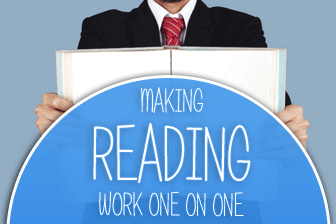One on one teaching can be a valuable experience to English as a second language students. With individualized attention, they can learn at their own paces, get instruction specific to their areas of weakness, and cover material targeted to their interests and needs.
Sometimes, though, one on one dynamics can be challenging. Students do not want their teachers to hover, but teachers want to make sure their students get the attention they deserve. This awkwardness can be especially challenging when teaching reading in an individualized setting. Still, it is possible to teach a great reading lesson even when you teach a class of one. Here are some tips to keep in mind when planning for and conducting an individual reading class.

Making Reading Work: 5 Never Fail One on One Tips
-
1
Warming up
Before giving your student a text to read during your session, spend a few minutes talking about the general topic that the article or text covers. You may want to ask your student what he already knows or what he would like to know about the topic. Because you only have one student, you can tailor your material to his specific interests and aspirations. This will keep him engaged and interested in the material as well as give him something to say about the topic from the start. For lower level students, you may want to modify a selection from the newspaper or a magazine, or use a selection from a textbook. For more advanced students, try to bring in authentic English material rather than selections written specifically for ESL students. Doing so will better prepare your student for the language he will encounter once he has completed your ESL program. Your text should be challenging but not overwhelming or intimidating. Find the right balance, and for each student that balance will be in a slightly different place.
-
2
Previewing Vocabulary
Previewing vocabulary with your students serves 3 purposes. By reminding your student with topic specific vocabulary she already knows, you bring to mind ideas about the subject at hand. She remembers past experiences, and this will enable her to retain what she learns in her present class experience more easily. Secondly, by defining the preview vocabulary words she does not know, you aid her comprehension as she reads the text. Because her comprehension is higher, she feels confident and makes good emotional associations with the topic and learns better. Finally, by previewing vocabulary that the text presents, you give her some context for making predictions about what she will read. Making predictions also helps aid in comprehension and language retention. So before you introduce your student to the text you plan to use, choose some topic specific vocabulary she will find in her reading as a preview. Doing so will aid her comprehension and retention as she reads.
-
3
Reading
Generally speaking, you should not ask your student to read aloud once you give him the text. Asking a student to read aloud, especially on the first read through a new piece of literature, may cause your student to feel uncomfortable. Having the teacher hover and listen to every syllable can be almost paralyzing and could set your student up for failure. Instead, allow your student to read to himself, and you do the same. This way you can review the content of the text and prepare to answer any questions your student had with the reading. Anticipate any sections he may struggle with, and have him make notes as he reads of anything that he finds difficult to understand.
-
4
Checking Comprehension
Checking comprehension after your student has read the selection is important, but do not trust her to tell you what she may not have understood. When asked if they understood, students will generally answer yes, whether they did or not. So make sure your student understood what she read by having her retell the information given in the selection. This can be as simple as asking her to retell what she read. You may want to give her some guidance by allowing her to refer back to either the text itself or the vocabulary you used in your preview time. If you want to challenge her even further, ask her to apply the information from the reading to solve a problem or give direction in regards to a case study.
-
5
Working on Pronunciation
If you are teaching more than reading to your ESL student, you may want to use this one on one time to work on his pronunciation. No one else will be around to criticize, and you can target specific pronunciation issues for your student. To do so, ask him to read part of the selection aloud. When he encounters a troublesome series of words, have him follow your own example by repeating what you read. Remember, when a student is struggling with pronouncing a multisyllabic word or phrase, start with the last syllable and have him repeat after you. Then add one syllable at a time and repeat, working backwards until he can pronounce the entire phrase correctly. Reading aloud can also offer a good opportunity to practice sentence inflection or reductions, which can be overlooked in pronunciation class.
By taking note of these simple strategies for teaching reading one on one, your student can benefit each and every time you meet together, but do not let it stop there.
These strategies can be modified for use in the traditional classroom, and your students will continue to thrive in their language learning.
Do you have any texts you find particularly appropriate for one on one reading lessons?
P.S. If you enjoyed this article, please help spread it by clicking one of those sharing buttons below. And if you are interested in more, you should follow our Facebook page where we share more about creative, non-boring ways to teach English.







